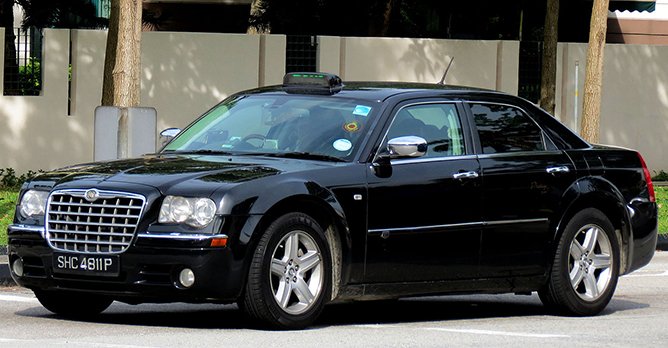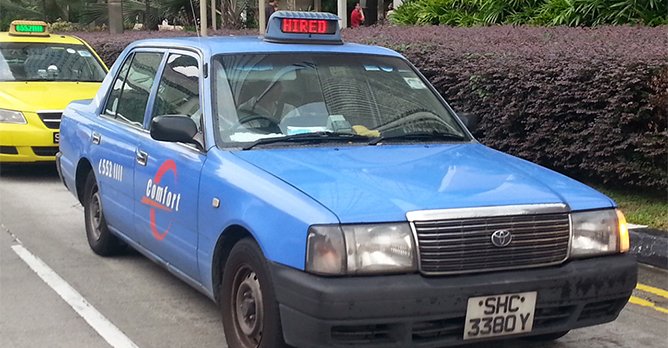Taxi tier list! From one-off Yellow-Tops to the original Crown Comfort
24 Mar 2022|5,627 views
It didn't feel too long ago that I was still a wee little child, waiting in line for half an hour with my family at a shopping centre to hop onto a cab. Sometimes, even after pressing the button to let cabbies on the road know a queue was forming, nothing blue would swing in.
How the times have changed. I don't remember the last time I stood by the side of the road with one arm frantically outstretched. Even when using one of the ride-hailing apps now, I end up hopping into a car - not a cab. And the numbers show: Private-hire vehicles now outnumber taxis five to one.
But taxis are returning briefly into the center of the spotlight, with the first fare hikes kicking in this March after close to a decade. As such, what better time than now to revisit some of the best ones that have plied Singapore's roads (with a tier list, no less, of course)?
Regarding the question of what makes a good taxi, a few qualities certainly come to mind. Practicality, for sure - generous cabin and boot space, as well as the efficiency, reliability, and sheer power to devour hundreds of kilometers on a daily basis competently and swiftly. But distinctiveness is important too.
For the sake of diversity, the crew amassed here also combines both household names with those that may have flown under the radar for the less-observant taxi passenger. And since these sorts of lists are absolutely objective and completely serious, we'll start by saying that there hasn't been a single taxi in memory that was genuinely terrible.
So, no - no poor F-graders this time.
E-Tier: BYD e6, HDT Taxis
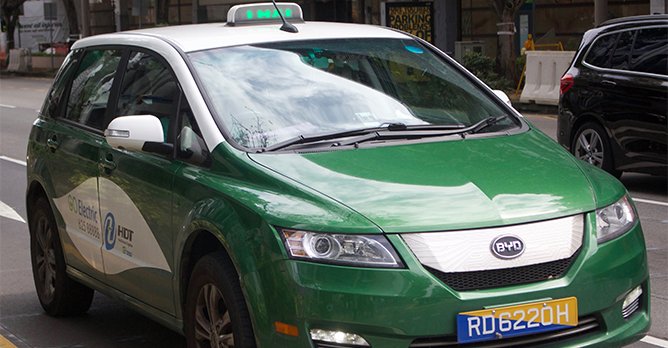
 Remember: It was HDT which tried the full-electric route first with the e6 (Credits: Wikimedia user/EurovisionNim) The BYD e6 promised much - not just on the inside, where a roomy cabin and 450 litres of boot space meant plenty of practicality for passengers.
Remember: It was HDT which tried the full-electric route first with the e6 (Credits: Wikimedia user/EurovisionNim) The BYD e6 promised much - not just on the inside, where a roomy cabin and 450 litres of boot space meant plenty of practicality for passengers.
Most significantly, it was Singapore's first ever fully-electric taxi. As evidence of the experimental attitude towards EVs back then, the picture here even shows the e6 - probably one of the earlier ones to hit the road - with the RD (research and development) plate.
Otherwise, however, the first-generation e6 was genuinely not much to marvel at. As per BYD's first slate of vehicles, its looks were completely anonymous, and the e6's drivetrain - now still severely lacking in torque - was even more drab back then for all its promises/credentials of electric power.
As HDT Taxis fell unfortunate prey to the pandemic, the first e6s were also scattered into the oblivion of the used car market. We're not too sad about that; the current generation is much better.
D-Tier: B5 Skoda Superb (Premier SilverArrows, SMART), Fiat Croma (Yellow-Top)
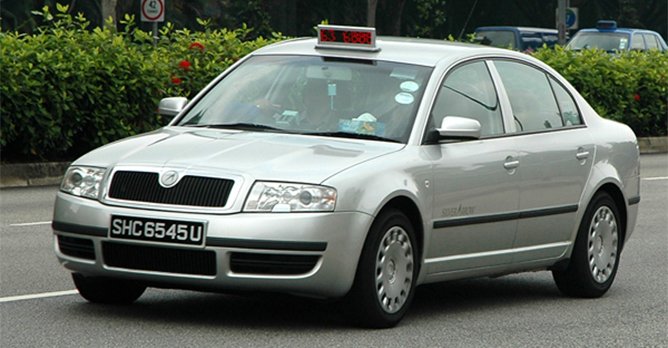
 The B5 Skoda Superb was by no measure a bad car, but absolutely pales in comparison to the one we have today (Credits: Taxi Singapore) 2003's liberalisation of the taxi market saw new names pouring onto the scene, including the likes of Premier Taxis (Silvercab), the now-defunct Smart, and later on, Prime Taxis and Trans-Cab. Aiding in adding an extra, shimmering dash of colour to our roads was the first-generation Skoda Superb.
The B5 Skoda Superb was by no measure a bad car, but absolutely pales in comparison to the one we have today (Credits: Taxi Singapore) 2003's liberalisation of the taxi market saw new names pouring onto the scene, including the likes of Premier Taxis (Silvercab), the now-defunct Smart, and later on, Prime Taxis and Trans-Cab. Aiding in adding an extra, shimmering dash of colour to our roads was the first-generation Skoda Superb.
The Superb's boot capacity back then was already quite impressive - 462 litres - but to give you an idea of how much the sedan has grown, the existing generation's liftback tailgate now opens up to 582 (!) litres. Legroom, as per Skoda standards, has naturally also simply gotten better over the years.
Fresh off VW Group's full acquisition of Skoda as a subsidiary, the B5 Superb used here was driven by a 1.9-litre TDI engine mated to a five-speed stick shifter. It wasn't a bad car by any measure; just rather forgettable, and far less premium when you consider the Škodas of today.

 Fiat never had a strong presence in Singapore, so to see this Croma rolling up must have a special experience (Credits: Wikimedia user/SmrtBusesLuver) As part of the Yellow-Top group of individually owned cabs, the Fiat Croma was an even more curious sight to behold, not simply because of its bloated proportions but also because... It just wasn't the sort of car you'd imagine a Singaporean driver wanting to buy. Much less a car you'd expect morphing into a Singaporean taxi, then.
Fiat never had a strong presence in Singapore, so to see this Croma rolling up must have a special experience (Credits: Wikimedia user/SmrtBusesLuver) As part of the Yellow-Top group of individually owned cabs, the Fiat Croma was an even more curious sight to behold, not simply because of its bloated proportions but also because... It just wasn't the sort of car you'd imagine a Singaporean driver wanting to buy. Much less a car you'd expect morphing into a Singaporean taxi, then.
Practicality was good though. Thanks to its almost-wagon like proportions, it had a huge 500 litre boot, with knock-down rear seats as well. Sadly, sgCarMart never reviewed the car, but accounts from abroad were largely positive about its engine and ride.
Just peek around the internet and you'll find a multitude of other more unique models that have worn the yellow and black livery over the years - including the likes of the Honda Airwave, a Toyota Avensis Tourer, and of course, a very special large fella we'll get to in a moment. The Croma wasn't what you'd call fantastic, but it was good. Points here for its practicality, but mostly its uniqueness.
C-Tier: Chevrolet Epica (TransCab, SMRT/STRIDES), Chrysler 300C (SMRT)
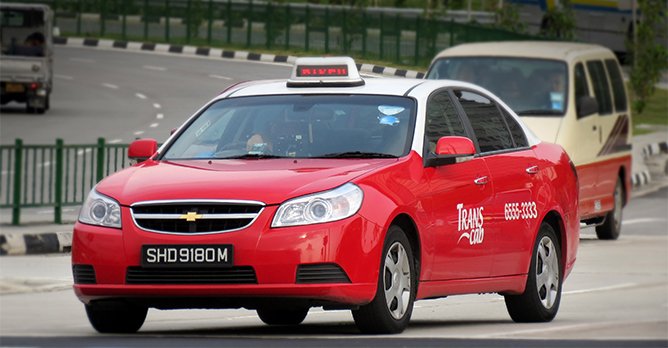
 The Chevrolet Epica had the guts to go toe-to-toe with other mid-sized sedans, but ultimately lost out (Credits: Wikimedia user/SmrtBusesLuver) The Chevrolet Epica, all things considered, was a worthy contender for a fleet staple. Delivering the sort of mid-sized practicality you'd want from a taxi, it had a trunk capacity of 480 litres, and was powered by a 2.0-litre, four-cylinder turbo-diesel engine.
The Chevrolet Epica had the guts to go toe-to-toe with other mid-sized sedans, but ultimately lost out (Credits: Wikimedia user/SmrtBusesLuver) The Chevrolet Epica, all things considered, was a worthy contender for a fleet staple. Delivering the sort of mid-sized practicality you'd want from a taxi, it had a trunk capacity of 480 litres, and was powered by a 2.0-litre, four-cylinder turbo-diesel engine.
We'd argue that the Epica actually briefly brushed shoulders with the golden goose of ubiquity. But against its more famous Korean brethren, it never really caught on as a household name.
As Kia and Hyundai made steady strides into global best-of rankings, the Chevrolet that we knew languished under the direction of GM Korea. The last of the Golden Bow-studded cars we got - the Cruze, Orlando and Captiva - were seen between the end of the 2017 and start of 2018, and a successor to the Epica as a taxi doesn't seem to be on the decks.
As evidence of how creative taxi company executives got at one point, SMRT also decided to bring in the Chrysler 300C in the late-2000s. Broad, menacing and full of promises of luxury, it boasted something you wouldn't expect from a taxi: A 3.0-litre V6 under the hood (alongside the partially CNG-powered Hyundai Azera).
To see something so imposing and ostensibly premium rolling up to a taxi stand was a novel experience, to say the least. But its value was… debatable. After all, unlike say, an Alphard, the limit of four passengers remained. Chrysler unfortunately also didn't - and still doesn't - have the synonymy with luxury that the German makers do locally.
And so, with a $5 flagdown rate (some companies didn't allow transport claims for this), the question always lingered as to whether the 300C was worth the literal price of admission. In a similar way to how you'd react to anyone who coughs or sneezes in public now, it was generally shunned by commuters. Unforgettable, though.
B-Tier: Mercedes-Benz E-Class (various), Toyota Hilux (Yellow-Top)
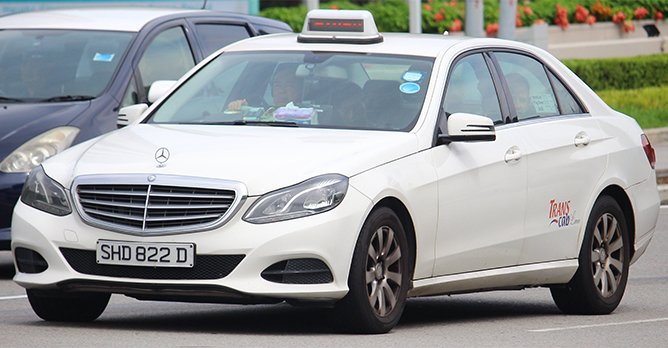
 A perennial favourite, the appeal of Merc's E-Class transcends time - as well as anti-fleet vehicle biases (Credits: Wikimedia user/EurovisionNim) Most models suffer a reputational blow when they become taxis or get inducted into fleets. If any name can emerge not just unscathed, but even more glorious than before from such a pummelling, however, it's Mercedes-Benz.
A perennial favourite, the appeal of Merc's E-Class transcends time - as well as anti-fleet vehicle biases (Credits: Wikimedia user/EurovisionNim) Most models suffer a reputational blow when they become taxis or get inducted into fleets. If any name can emerge not just unscathed, but even more glorious than before from such a pummelling, however, it's Mercedes-Benz.
The E-Class, Merc's mid-sized entrant, persisted as a (white) mainstay in the taxi scene for at least four generations, spanning the W124 all the way to the W212.
Without having to gawk at a $5 flag-down rate, you'd still be guaranteed the most comfortable, hushed, and sleep-inducing of taxi rides. And all this in spite of the diesel engines used too. This was luxury served perfectly; not too under- nor overcooked.
To follow up the omnipresent E-Class with something much more obscure feels like a risky move, but seriously: How cool is it to have an actual heavy duty vehicle as a taxi? Picking up (ha ha) where we left off with the Yellow-Tops, this double-cab, covered variant of the Toyota Hilux was also a one-off in Singapore.
Powered by a 3.0-litre straight-four turbo-diesel, and with a cargo area and payload certainly outstripping any other taxi on the road, it's safe to say nothing came - or will come close - in the hauling department. We also reckon no other Hilux on Singapore's roads since time immemorial has managed to escape the 70km/h barrier (legally), since this was registered with a taxi rather than commercial vehicle plate.
Seeing as Hiluxes are known for being indestructible, this beast could have well persisted on our roads - if not for a pesky thing called 'emissions regulations'. Legend has it that IKEA taxi stands are still mourning its loss. (Fun fact: This particular generation of Hiluxes also marked Toyota's introduction of our once-favourite model.)
A-Tier: London Taxi TX1 (SMRT/STRIDES), Hyundai Sonata (ComfortDelgro)
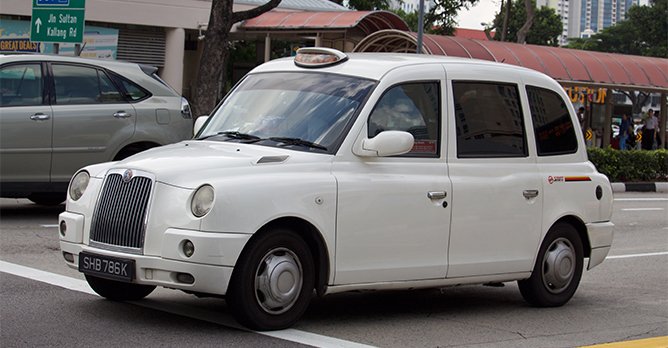
 While some London Taxis still ply our roads, their modern day successor doesn't appear to be coming over (Credits: Wikimedia user/EurovisionNim) Before the diversification of Singapore's taxi scene, there was only a handful taxis on our roads that could take a family of five. But even if it didn't boast that special capability, the London Taxi would have still stood out.
While some London Taxis still ply our roads, their modern day successor doesn't appear to be coming over (Credits: Wikimedia user/EurovisionNim) Before the diversification of Singapore's taxi scene, there was only a handful taxis on our roads that could take a family of five. But even if it didn't boast that special capability, the London Taxi would have still stood out.
After all, how could it not? Few vehicles, much less taxis, possess such natural charm, with its long history, tight turning radius, and of course, cheerful, wide-eyed face coming together in an unmistakeable package.
Crucially, the London Taxi has also always helped in making our transport scene more inclusive, and not just to bigger families. Its wide-opening doors and integrated ramps preceded low-floor buses in helping to ferry wheelchair-bound people around comfortably. It also made an appearance in the music video of 2002's NDP song. Evidence, surely, that you've made your mark. A shame, then, that we don't seem to be getting the plug-in hybrid version that modern London itself currently uses.
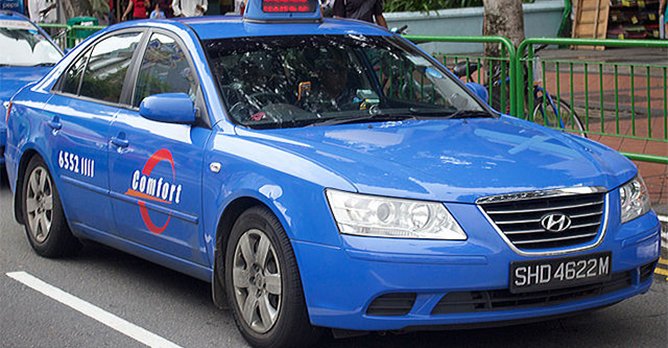
 ComfortDelgro's Sonata taxis helped to introduce cabbies to automatic transmissions (Credits: Wikimedia user/EurovisionNim) The Hyundai Sonata, on the other hand, was special in other ways.
ComfortDelgro's Sonata taxis helped to introduce cabbies to automatic transmissions (Credits: Wikimedia user/EurovisionNim) The Hyundai Sonata, on the other hand, was special in other ways.
It was arguably the Sonata that sparked a new wave of torquey taxis (as well as nausea-inducement, at the hands of a - shall we say - spirited taxi driver) as turbo-diesels became more powerful. Powered by a 2.0-litre CRDi engine, it was suddenly more common to see cabbies giving confused Civic drivers a short dash for their money when the lights turned green. But it wasn't all show and no go (or is it the other way round?) as a taxi; boot space was generous at 562 litres.
As the direct successor to Singapore's original 'it taxi' (we're coming to that one), the Sonata was also significant for other reasons. It marked a departure from a well-known Japanese brand, and accompanied the rise of Korean marques in Singapore (and worldwide) as appreciated alternatives. More importantly, its entrance was a turning point in the taxi scene by introducing automatic transmissions en masse.
Ultimately, ComfortDelgro's Sonatas were replaced by other Hyundais down the line. Nonetheless, there's something that just doesn't make those models stand out in the same way. Was it the rise of the Vezel towards national-car status that overshadowed their introductions? Or just nostalgia colouring our vision? We're not sure exactly why.
S-Tier: Toyota Crown Comfort (ComfortDelgro mostly, Yellow-Tops, SMART, Premier Silvercabs)
The sight of beaded seat covers, the smell of pandan leaves, the sound of revs building ever so often, and of course, the lurching sensation from a manual gearbox (or perhaps the less than pleasant driving of your cabbie).
No, no other taxi - not even the Nissan Cedric - comes close to the place the Toyota Crown Comfort has moulded for itself in Singaporean taxi history. It doesn't matter whether you loved or hated it; you remember the Crown Comfort effortlessly, the same way you remember the national pledge, or the first nursery rhyme you learned in pre-school.
Created by Toyota expressly for the purpose of taxi fleets (check out Toyota's deliciously retro 1995 press release here), this box-on-wheels came with many important qualities for frequent use, such as a frugal engine, wide-opening doors, Toyota-standard reliability, as well as cheap spare parts. Everything could be chalked down to its functional shape too. Headroom? Legroom? Boot space? Check, check, check.
Some Crown Comforts didn't even have alloy wheels when they were idling at taxi stands from Orchard Road to Hougang Mall between the late nineties through the noughties. But no matter - this was one instance in which function and form became so closely intertwined over the decades that when looking back now, every bit is fondly appreciated.
Certified S-tier, the Crown Comfort isn't just a part of Singaporean taxi history - it's one of our automotive legends.
In the mood for another tier list? Check out the one we made for SUVs and flash floods!
Which SUVs could handle our floods?
How the times have changed. I don't remember the last time I stood by the side of the road with one arm frantically outstretched. Even when using one of the ride-hailing apps now, I end up hopping into a car - not a cab. And the numbers show: Private-hire vehicles now outnumber taxis five to one.
But taxis are returning briefly into the center of the spotlight, with the first fare hikes kicking in this March after close to a decade. As such, what better time than now to revisit some of the best ones that have plied Singapore's roads (with a tier list, no less, of course)?
Regarding the question of what makes a good taxi, a few qualities certainly come to mind. Practicality, for sure - generous cabin and boot space, as well as the efficiency, reliability, and sheer power to devour hundreds of kilometers on a daily basis competently and swiftly. But distinctiveness is important too.
For the sake of diversity, the crew amassed here also combines both household names with those that may have flown under the radar for the less-observant taxi passenger. And since these sorts of lists are absolutely objective and completely serious, we'll start by saying that there hasn't been a single taxi in memory that was genuinely terrible.
So, no - no poor F-graders this time.
E-Tier: BYD e6, HDT Taxis

Most significantly, it was Singapore's first ever fully-electric taxi. As evidence of the experimental attitude towards EVs back then, the picture here even shows the e6 - probably one of the earlier ones to hit the road - with the RD (research and development) plate.
Otherwise, however, the first-generation e6 was genuinely not much to marvel at. As per BYD's first slate of vehicles, its looks were completely anonymous, and the e6's drivetrain - now still severely lacking in torque - was even more drab back then for all its promises/credentials of electric power.
As HDT Taxis fell unfortunate prey to the pandemic, the first e6s were also scattered into the oblivion of the used car market. We're not too sad about that; the current generation is much better.
D-Tier: B5 Skoda Superb (Premier SilverArrows, SMART), Fiat Croma (Yellow-Top)

The Superb's boot capacity back then was already quite impressive - 462 litres - but to give you an idea of how much the sedan has grown, the existing generation's liftback tailgate now opens up to 582 (!) litres. Legroom, as per Skoda standards, has naturally also simply gotten better over the years.
Fresh off VW Group's full acquisition of Skoda as a subsidiary, the B5 Superb used here was driven by a 1.9-litre TDI engine mated to a five-speed stick shifter. It wasn't a bad car by any measure; just rather forgettable, and far less premium when you consider the Škodas of today.

Practicality was good though. Thanks to its almost-wagon like proportions, it had a huge 500 litre boot, with knock-down rear seats as well. Sadly, sgCarMart never reviewed the car, but accounts from abroad were largely positive about its engine and ride.
Just peek around the internet and you'll find a multitude of other more unique models that have worn the yellow and black livery over the years - including the likes of the Honda Airwave, a Toyota Avensis Tourer, and of course, a very special large fella we'll get to in a moment. The Croma wasn't what you'd call fantastic, but it was good. Points here for its practicality, but mostly its uniqueness.
C-Tier: Chevrolet Epica (TransCab, SMRT/STRIDES), Chrysler 300C (SMRT)

We'd argue that the Epica actually briefly brushed shoulders with the golden goose of ubiquity. But against its more famous Korean brethren, it never really caught on as a household name.
As Kia and Hyundai made steady strides into global best-of rankings, the Chevrolet that we knew languished under the direction of GM Korea. The last of the Golden Bow-studded cars we got - the Cruze, Orlando and Captiva - were seen between the end of the 2017 and start of 2018, and a successor to the Epica as a taxi doesn't seem to be on the decks.
As evidence of how creative taxi company executives got at one point, SMRT also decided to bring in the Chrysler 300C in the late-2000s. Broad, menacing and full of promises of luxury, it boasted something you wouldn't expect from a taxi: A 3.0-litre V6 under the hood (alongside the partially CNG-powered Hyundai Azera).
To see something so imposing and ostensibly premium rolling up to a taxi stand was a novel experience, to say the least. But its value was… debatable. After all, unlike say, an Alphard, the limit of four passengers remained. Chrysler unfortunately also didn't - and still doesn't - have the synonymy with luxury that the German makers do locally.
And so, with a $5 flagdown rate (some companies didn't allow transport claims for this), the question always lingered as to whether the 300C was worth the literal price of admission. In a similar way to how you'd react to anyone who coughs or sneezes in public now, it was generally shunned by commuters. Unforgettable, though.
B-Tier: Mercedes-Benz E-Class (various), Toyota Hilux (Yellow-Top)

The E-Class, Merc's mid-sized entrant, persisted as a (white) mainstay in the taxi scene for at least four generations, spanning the W124 all the way to the W212.
Without having to gawk at a $5 flag-down rate, you'd still be guaranteed the most comfortable, hushed, and sleep-inducing of taxi rides. And all this in spite of the diesel engines used too. This was luxury served perfectly; not too under- nor overcooked.
To follow up the omnipresent E-Class with something much more obscure feels like a risky move, but seriously: How cool is it to have an actual heavy duty vehicle as a taxi? Picking up (ha ha) where we left off with the Yellow-Tops, this double-cab, covered variant of the Toyota Hilux was also a one-off in Singapore.
Powered by a 3.0-litre straight-four turbo-diesel, and with a cargo area and payload certainly outstripping any other taxi on the road, it's safe to say nothing came - or will come close - in the hauling department. We also reckon no other Hilux on Singapore's roads since time immemorial has managed to escape the 70km/h barrier (legally), since this was registered with a taxi rather than commercial vehicle plate.
Seeing as Hiluxes are known for being indestructible, this beast could have well persisted on our roads - if not for a pesky thing called 'emissions regulations'. Legend has it that IKEA taxi stands are still mourning its loss. (Fun fact: This particular generation of Hiluxes also marked Toyota's introduction of our once-favourite model.)
A-Tier: London Taxi TX1 (SMRT/STRIDES), Hyundai Sonata (ComfortDelgro)

After all, how could it not? Few vehicles, much less taxis, possess such natural charm, with its long history, tight turning radius, and of course, cheerful, wide-eyed face coming together in an unmistakeable package.
Crucially, the London Taxi has also always helped in making our transport scene more inclusive, and not just to bigger families. Its wide-opening doors and integrated ramps preceded low-floor buses in helping to ferry wheelchair-bound people around comfortably. It also made an appearance in the music video of 2002's NDP song. Evidence, surely, that you've made your mark. A shame, then, that we don't seem to be getting the plug-in hybrid version that modern London itself currently uses.

It was arguably the Sonata that sparked a new wave of torquey taxis (as well as nausea-inducement, at the hands of a - shall we say - spirited taxi driver) as turbo-diesels became more powerful. Powered by a 2.0-litre CRDi engine, it was suddenly more common to see cabbies giving confused Civic drivers a short dash for their money when the lights turned green. But it wasn't all show and no go (or is it the other way round?) as a taxi; boot space was generous at 562 litres.
As the direct successor to Singapore's original 'it taxi' (we're coming to that one), the Sonata was also significant for other reasons. It marked a departure from a well-known Japanese brand, and accompanied the rise of Korean marques in Singapore (and worldwide) as appreciated alternatives. More importantly, its entrance was a turning point in the taxi scene by introducing automatic transmissions en masse.
Ultimately, ComfortDelgro's Sonatas were replaced by other Hyundais down the line. Nonetheless, there's something that just doesn't make those models stand out in the same way. Was it the rise of the Vezel towards national-car status that overshadowed their introductions? Or just nostalgia colouring our vision? We're not sure exactly why.
S-Tier: Toyota Crown Comfort (ComfortDelgro mostly, Yellow-Tops, SMART, Premier Silvercabs)
The sight of beaded seat covers, the smell of pandan leaves, the sound of revs building ever so often, and of course, the lurching sensation from a manual gearbox (or perhaps the less than pleasant driving of your cabbie).
No, no other taxi - not even the Nissan Cedric - comes close to the place the Toyota Crown Comfort has moulded for itself in Singaporean taxi history. It doesn't matter whether you loved or hated it; you remember the Crown Comfort effortlessly, the same way you remember the national pledge, or the first nursery rhyme you learned in pre-school.
Created by Toyota expressly for the purpose of taxi fleets (check out Toyota's deliciously retro 1995 press release here), this box-on-wheels came with many important qualities for frequent use, such as a frugal engine, wide-opening doors, Toyota-standard reliability, as well as cheap spare parts. Everything could be chalked down to its functional shape too. Headroom? Legroom? Boot space? Check, check, check.
Some Crown Comforts didn't even have alloy wheels when they were idling at taxi stands from Orchard Road to Hougang Mall between the late nineties through the noughties. But no matter - this was one instance in which function and form became so closely intertwined over the decades that when looking back now, every bit is fondly appreciated.
Certified S-tier, the Crown Comfort isn't just a part of Singaporean taxi history - it's one of our automotive legends.
In the mood for another tier list? Check out the one we made for SUVs and flash floods!
Which SUVs could handle our floods?
It didn't feel too long ago that I was still a wee little child, waiting in line for half an hour with my family at a shopping centre to hop onto a cab. Sometimes, even after pressing the button to let cabbies on the road know a queue was forming, nothing blue would swing in.
How the times have changed. I don't remember the last time I stood by the side of the road with one arm frantically outstretched. Even when using one of the ride-hailing apps now, I end up hopping into a car - not a cab. And the numbers show: Private-hire vehicles now outnumber taxis five to one.
But taxis are returning briefly into the center of the spotlight, with the first fare hikes kicking in this March after close to a decade. As such, what better time than now to revisit some of the best ones that have plied Singapore's roads (with a tier list, no less, of course)?
Regarding the question of what makes a good taxi, a few qualities certainly come to mind. Practicality, for sure - generous cabin and boot space, as well as the efficiency, reliability, and sheer power to devour hundreds of kilometers on a daily basis competently and swiftly. But distinctiveness is important too.
For the sake of diversity, the crew amassed here also combines both household names with those that may have flown under the radar for the less-observant taxi passenger. And since these sorts of lists are absolutely objective and completely serious, we'll start by saying that there hasn't been a single taxi in memory that was genuinely terrible.
So, no - no poor F-graders this time.
E-Tier: BYD e6, HDT Taxis

 Remember: It was HDT which tried the full-electric route first with the e6 (Credits: Wikimedia user/EurovisionNim) The BYD e6 promised much - not just on the inside, where a roomy cabin and 450 litres of boot space meant plenty of practicality for passengers.
Remember: It was HDT which tried the full-electric route first with the e6 (Credits: Wikimedia user/EurovisionNim) The BYD e6 promised much - not just on the inside, where a roomy cabin and 450 litres of boot space meant plenty of practicality for passengers.
Most significantly, it was Singapore's first ever fully-electric taxi. As evidence of the experimental attitude towards EVs back then, the picture here even shows the e6 - probably one of the earlier ones to hit the road - with the RD (research and development) plate.
Otherwise, however, the first-generation e6 was genuinely not much to marvel at. As per BYD's first slate of vehicles, its looks were completely anonymous, and the e6's drivetrain - now still severely lacking in torque - was even more drab back then for all its promises/credentials of electric power.
As HDT Taxis fell unfortunate prey to the pandemic, the first e6s were also scattered into the oblivion of the used car market. We're not too sad about that; the current generation is much better.
D-Tier: B5 Skoda Superb (Premier SilverArrows, SMART), Fiat Croma (Yellow-Top)

 The B5 Skoda Superb was by no measure a bad car, but absolutely pales in comparison to the one we have today (Credits: Taxi Singapore) 2003's liberalisation of the taxi market saw new names pouring onto the scene, including the likes of Premier Taxis (Silvercab), the now-defunct Smart, and later on, Prime Taxis and Trans-Cab. Aiding in adding an extra, shimmering dash of colour to our roads was the first-generation Skoda Superb.
The B5 Skoda Superb was by no measure a bad car, but absolutely pales in comparison to the one we have today (Credits: Taxi Singapore) 2003's liberalisation of the taxi market saw new names pouring onto the scene, including the likes of Premier Taxis (Silvercab), the now-defunct Smart, and later on, Prime Taxis and Trans-Cab. Aiding in adding an extra, shimmering dash of colour to our roads was the first-generation Skoda Superb.
The Superb's boot capacity back then was already quite impressive - 462 litres - but to give you an idea of how much the sedan has grown, the existing generation's liftback tailgate now opens up to 582 (!) litres. Legroom, as per Skoda standards, has naturally also simply gotten better over the years.
Fresh off VW Group's full acquisition of Skoda as a subsidiary, the B5 Superb used here was driven by a 1.9-litre TDI engine mated to a five-speed stick shifter. It wasn't a bad car by any measure; just rather forgettable, and far less premium when you consider the Škodas of today.

 Fiat never had a strong presence in Singapore, so to see this Croma rolling up must have a special experience (Credits: Wikimedia user/SmrtBusesLuver) As part of the Yellow-Top group of individually owned cabs, the Fiat Croma was an even more curious sight to behold, not simply because of its bloated proportions but also because... It just wasn't the sort of car you'd imagine a Singaporean driver wanting to buy. Much less a car you'd expect morphing into a Singaporean taxi, then.
Fiat never had a strong presence in Singapore, so to see this Croma rolling up must have a special experience (Credits: Wikimedia user/SmrtBusesLuver) As part of the Yellow-Top group of individually owned cabs, the Fiat Croma was an even more curious sight to behold, not simply because of its bloated proportions but also because... It just wasn't the sort of car you'd imagine a Singaporean driver wanting to buy. Much less a car you'd expect morphing into a Singaporean taxi, then.
Practicality was good though. Thanks to its almost-wagon like proportions, it had a huge 500 litre boot, with knock-down rear seats as well. Sadly, sgCarMart never reviewed the car, but accounts from abroad were largely positive about its engine and ride.
Just peek around the internet and you'll find a multitude of other more unique models that have worn the yellow and black livery over the years - including the likes of the Honda Airwave, a Toyota Avensis Tourer, and of course, a very special large fella we'll get to in a moment. The Croma wasn't what you'd call fantastic, but it was good. Points here for its practicality, but mostly its uniqueness.
C-Tier: Chevrolet Epica (TransCab, SMRT/STRIDES), Chrysler 300C (SMRT)

 The Chevrolet Epica had the guts to go toe-to-toe with other mid-sized sedans, but ultimately lost out (Credits: Wikimedia user/SmrtBusesLuver) The Chevrolet Epica, all things considered, was a worthy contender for a fleet staple. Delivering the sort of mid-sized practicality you'd want from a taxi, it had a trunk capacity of 480 litres, and was powered by a 2.0-litre, four-cylinder turbo-diesel engine.
The Chevrolet Epica had the guts to go toe-to-toe with other mid-sized sedans, but ultimately lost out (Credits: Wikimedia user/SmrtBusesLuver) The Chevrolet Epica, all things considered, was a worthy contender for a fleet staple. Delivering the sort of mid-sized practicality you'd want from a taxi, it had a trunk capacity of 480 litres, and was powered by a 2.0-litre, four-cylinder turbo-diesel engine.
We'd argue that the Epica actually briefly brushed shoulders with the golden goose of ubiquity. But against its more famous Korean brethren, it never really caught on as a household name.
As Kia and Hyundai made steady strides into global best-of rankings, the Chevrolet that we knew languished under the direction of GM Korea. The last of the Golden Bow-studded cars we got - the Cruze, Orlando and Captiva - were seen between the end of the 2017 and start of 2018, and a successor to the Epica as a taxi doesn't seem to be on the decks.
As evidence of how creative taxi company executives got at one point, SMRT also decided to bring in the Chrysler 300C in the late-2000s. Broad, menacing and full of promises of luxury, it boasted something you wouldn't expect from a taxi: A 3.0-litre V6 under the hood (alongside the partially CNG-powered Hyundai Azera).
To see something so imposing and ostensibly premium rolling up to a taxi stand was a novel experience, to say the least. But its value was… debatable. After all, unlike say, an Alphard, the limit of four passengers remained. Chrysler unfortunately also didn't - and still doesn't - have the synonymy with luxury that the German makers do locally.
And so, with a $5 flagdown rate (some companies didn't allow transport claims for this), the question always lingered as to whether the 300C was worth the literal price of admission. In a similar way to how you'd react to anyone who coughs or sneezes in public now, it was generally shunned by commuters. Unforgettable, though.
B-Tier: Mercedes-Benz E-Class (various), Toyota Hilux (Yellow-Top)

 A perennial favourite, the appeal of Merc's E-Class transcends time - as well as anti-fleet vehicle biases (Credits: Wikimedia user/EurovisionNim) Most models suffer a reputational blow when they become taxis or get inducted into fleets. If any name can emerge not just unscathed, but even more glorious than before from such a pummelling, however, it's Mercedes-Benz.
A perennial favourite, the appeal of Merc's E-Class transcends time - as well as anti-fleet vehicle biases (Credits: Wikimedia user/EurovisionNim) Most models suffer a reputational blow when they become taxis or get inducted into fleets. If any name can emerge not just unscathed, but even more glorious than before from such a pummelling, however, it's Mercedes-Benz.
The E-Class, Merc's mid-sized entrant, persisted as a (white) mainstay in the taxi scene for at least four generations, spanning the W124 all the way to the W212.
Without having to gawk at a $5 flag-down rate, you'd still be guaranteed the most comfortable, hushed, and sleep-inducing of taxi rides. And all this in spite of the diesel engines used too. This was luxury served perfectly; not too under- nor overcooked.
To follow up the omnipresent E-Class with something much more obscure feels like a risky move, but seriously: How cool is it to have an actual heavy duty vehicle as a taxi? Picking up (ha ha) where we left off with the Yellow-Tops, this double-cab, covered variant of the Toyota Hilux was also a one-off in Singapore.
Powered by a 3.0-litre straight-four turbo-diesel, and with a cargo area and payload certainly outstripping any other taxi on the road, it's safe to say nothing came - or will come close - in the hauling department. We also reckon no other Hilux on Singapore's roads since time immemorial has managed to escape the 70km/h barrier (legally), since this was registered with a taxi rather than commercial vehicle plate.
Seeing as Hiluxes are known for being indestructible, this beast could have well persisted on our roads - if not for a pesky thing called 'emissions regulations'. Legend has it that IKEA taxi stands are still mourning its loss. (Fun fact: This particular generation of Hiluxes also marked Toyota's introduction of our once-favourite model.)
A-Tier: London Taxi TX1 (SMRT/STRIDES), Hyundai Sonata (ComfortDelgro)

 While some London Taxis still ply our roads, their modern day successor doesn't appear to be coming over (Credits: Wikimedia user/EurovisionNim) Before the diversification of Singapore's taxi scene, there was only a handful taxis on our roads that could take a family of five. But even if it didn't boast that special capability, the London Taxi would have still stood out.
While some London Taxis still ply our roads, their modern day successor doesn't appear to be coming over (Credits: Wikimedia user/EurovisionNim) Before the diversification of Singapore's taxi scene, there was only a handful taxis on our roads that could take a family of five. But even if it didn't boast that special capability, the London Taxi would have still stood out.
After all, how could it not? Few vehicles, much less taxis, possess such natural charm, with its long history, tight turning radius, and of course, cheerful, wide-eyed face coming together in an unmistakeable package.
Crucially, the London Taxi has also always helped in making our transport scene more inclusive, and not just to bigger families. Its wide-opening doors and integrated ramps preceded low-floor buses in helping to ferry wheelchair-bound people around comfortably. It also made an appearance in the music video of 2002's NDP song. Evidence, surely, that you've made your mark. A shame, then, that we don't seem to be getting the plug-in hybrid version that modern London itself currently uses.

 ComfortDelgro's Sonata taxis helped to introduce cabbies to automatic transmissions (Credits: Wikimedia user/EurovisionNim) The Hyundai Sonata, on the other hand, was special in other ways.
ComfortDelgro's Sonata taxis helped to introduce cabbies to automatic transmissions (Credits: Wikimedia user/EurovisionNim) The Hyundai Sonata, on the other hand, was special in other ways.
It was arguably the Sonata that sparked a new wave of torquey taxis (as well as nausea-inducement, at the hands of a - shall we say - spirited taxi driver) as turbo-diesels became more powerful. Powered by a 2.0-litre CRDi engine, it was suddenly more common to see cabbies giving confused Civic drivers a short dash for their money when the lights turned green. But it wasn't all show and no go (or is it the other way round?) as a taxi; boot space was generous at 562 litres.
As the direct successor to Singapore's original 'it taxi' (we're coming to that one), the Sonata was also significant for other reasons. It marked a departure from a well-known Japanese brand, and accompanied the rise of Korean marques in Singapore (and worldwide) as appreciated alternatives. More importantly, its entrance was a turning point in the taxi scene by introducing automatic transmissions en masse.
Ultimately, ComfortDelgro's Sonatas were replaced by other Hyundais down the line. Nonetheless, there's something that just doesn't make those models stand out in the same way. Was it the rise of the Vezel towards national-car status that overshadowed their introductions? Or just nostalgia colouring our vision? We're not sure exactly why.
S-Tier: Toyota Crown Comfort (ComfortDelgro mostly, Yellow-Tops, SMART, Premier Silvercabs)
The sight of beaded seat covers, the smell of pandan leaves, the sound of revs building ever so often, and of course, the lurching sensation from a manual gearbox (or perhaps the less than pleasant driving of your cabbie).
No, no other taxi - not even the Nissan Cedric - comes close to the place the Toyota Crown Comfort has moulded for itself in Singaporean taxi history. It doesn't matter whether you loved or hated it; you remember the Crown Comfort effortlessly, the same way you remember the national pledge, or the first nursery rhyme you learned in pre-school.
Created by Toyota expressly for the purpose of taxi fleets (check out Toyota's deliciously retro 1995 press release here), this box-on-wheels came with many important qualities for frequent use, such as a frugal engine, wide-opening doors, Toyota-standard reliability, as well as cheap spare parts. Everything could be chalked down to its functional shape too. Headroom? Legroom? Boot space? Check, check, check.
Some Crown Comforts didn't even have alloy wheels when they were idling at taxi stands from Orchard Road to Hougang Mall between the late nineties through the noughties. But no matter - this was one instance in which function and form became so closely intertwined over the decades that when looking back now, every bit is fondly appreciated.
Certified S-tier, the Crown Comfort isn't just a part of Singaporean taxi history - it's one of our automotive legends.
In the mood for another tier list? Check out the one we made for SUVs and flash floods!
Which SUVs could handle our floods?
How the times have changed. I don't remember the last time I stood by the side of the road with one arm frantically outstretched. Even when using one of the ride-hailing apps now, I end up hopping into a car - not a cab. And the numbers show: Private-hire vehicles now outnumber taxis five to one.
But taxis are returning briefly into the center of the spotlight, with the first fare hikes kicking in this March after close to a decade. As such, what better time than now to revisit some of the best ones that have plied Singapore's roads (with a tier list, no less, of course)?
Regarding the question of what makes a good taxi, a few qualities certainly come to mind. Practicality, for sure - generous cabin and boot space, as well as the efficiency, reliability, and sheer power to devour hundreds of kilometers on a daily basis competently and swiftly. But distinctiveness is important too.
For the sake of diversity, the crew amassed here also combines both household names with those that may have flown under the radar for the less-observant taxi passenger. And since these sorts of lists are absolutely objective and completely serious, we'll start by saying that there hasn't been a single taxi in memory that was genuinely terrible.
So, no - no poor F-graders this time.
E-Tier: BYD e6, HDT Taxis

Most significantly, it was Singapore's first ever fully-electric taxi. As evidence of the experimental attitude towards EVs back then, the picture here even shows the e6 - probably one of the earlier ones to hit the road - with the RD (research and development) plate.
Otherwise, however, the first-generation e6 was genuinely not much to marvel at. As per BYD's first slate of vehicles, its looks were completely anonymous, and the e6's drivetrain - now still severely lacking in torque - was even more drab back then for all its promises/credentials of electric power.
As HDT Taxis fell unfortunate prey to the pandemic, the first e6s were also scattered into the oblivion of the used car market. We're not too sad about that; the current generation is much better.
D-Tier: B5 Skoda Superb (Premier SilverArrows, SMART), Fiat Croma (Yellow-Top)

The Superb's boot capacity back then was already quite impressive - 462 litres - but to give you an idea of how much the sedan has grown, the existing generation's liftback tailgate now opens up to 582 (!) litres. Legroom, as per Skoda standards, has naturally also simply gotten better over the years.
Fresh off VW Group's full acquisition of Skoda as a subsidiary, the B5 Superb used here was driven by a 1.9-litre TDI engine mated to a five-speed stick shifter. It wasn't a bad car by any measure; just rather forgettable, and far less premium when you consider the Škodas of today.

Practicality was good though. Thanks to its almost-wagon like proportions, it had a huge 500 litre boot, with knock-down rear seats as well. Sadly, sgCarMart never reviewed the car, but accounts from abroad were largely positive about its engine and ride.
Just peek around the internet and you'll find a multitude of other more unique models that have worn the yellow and black livery over the years - including the likes of the Honda Airwave, a Toyota Avensis Tourer, and of course, a very special large fella we'll get to in a moment. The Croma wasn't what you'd call fantastic, but it was good. Points here for its practicality, but mostly its uniqueness.
C-Tier: Chevrolet Epica (TransCab, SMRT/STRIDES), Chrysler 300C (SMRT)

We'd argue that the Epica actually briefly brushed shoulders with the golden goose of ubiquity. But against its more famous Korean brethren, it never really caught on as a household name.
As Kia and Hyundai made steady strides into global best-of rankings, the Chevrolet that we knew languished under the direction of GM Korea. The last of the Golden Bow-studded cars we got - the Cruze, Orlando and Captiva - were seen between the end of the 2017 and start of 2018, and a successor to the Epica as a taxi doesn't seem to be on the decks.
As evidence of how creative taxi company executives got at one point, SMRT also decided to bring in the Chrysler 300C in the late-2000s. Broad, menacing and full of promises of luxury, it boasted something you wouldn't expect from a taxi: A 3.0-litre V6 under the hood (alongside the partially CNG-powered Hyundai Azera).
To see something so imposing and ostensibly premium rolling up to a taxi stand was a novel experience, to say the least. But its value was… debatable. After all, unlike say, an Alphard, the limit of four passengers remained. Chrysler unfortunately also didn't - and still doesn't - have the synonymy with luxury that the German makers do locally.
And so, with a $5 flagdown rate (some companies didn't allow transport claims for this), the question always lingered as to whether the 300C was worth the literal price of admission. In a similar way to how you'd react to anyone who coughs or sneezes in public now, it was generally shunned by commuters. Unforgettable, though.
B-Tier: Mercedes-Benz E-Class (various), Toyota Hilux (Yellow-Top)

The E-Class, Merc's mid-sized entrant, persisted as a (white) mainstay in the taxi scene for at least four generations, spanning the W124 all the way to the W212.
Without having to gawk at a $5 flag-down rate, you'd still be guaranteed the most comfortable, hushed, and sleep-inducing of taxi rides. And all this in spite of the diesel engines used too. This was luxury served perfectly; not too under- nor overcooked.
To follow up the omnipresent E-Class with something much more obscure feels like a risky move, but seriously: How cool is it to have an actual heavy duty vehicle as a taxi? Picking up (ha ha) where we left off with the Yellow-Tops, this double-cab, covered variant of the Toyota Hilux was also a one-off in Singapore.
Powered by a 3.0-litre straight-four turbo-diesel, and with a cargo area and payload certainly outstripping any other taxi on the road, it's safe to say nothing came - or will come close - in the hauling department. We also reckon no other Hilux on Singapore's roads since time immemorial has managed to escape the 70km/h barrier (legally), since this was registered with a taxi rather than commercial vehicle plate.
Seeing as Hiluxes are known for being indestructible, this beast could have well persisted on our roads - if not for a pesky thing called 'emissions regulations'. Legend has it that IKEA taxi stands are still mourning its loss. (Fun fact: This particular generation of Hiluxes also marked Toyota's introduction of our once-favourite model.)
A-Tier: London Taxi TX1 (SMRT/STRIDES), Hyundai Sonata (ComfortDelgro)

After all, how could it not? Few vehicles, much less taxis, possess such natural charm, with its long history, tight turning radius, and of course, cheerful, wide-eyed face coming together in an unmistakeable package.
Crucially, the London Taxi has also always helped in making our transport scene more inclusive, and not just to bigger families. Its wide-opening doors and integrated ramps preceded low-floor buses in helping to ferry wheelchair-bound people around comfortably. It also made an appearance in the music video of 2002's NDP song. Evidence, surely, that you've made your mark. A shame, then, that we don't seem to be getting the plug-in hybrid version that modern London itself currently uses.

It was arguably the Sonata that sparked a new wave of torquey taxis (as well as nausea-inducement, at the hands of a - shall we say - spirited taxi driver) as turbo-diesels became more powerful. Powered by a 2.0-litre CRDi engine, it was suddenly more common to see cabbies giving confused Civic drivers a short dash for their money when the lights turned green. But it wasn't all show and no go (or is it the other way round?) as a taxi; boot space was generous at 562 litres.
As the direct successor to Singapore's original 'it taxi' (we're coming to that one), the Sonata was also significant for other reasons. It marked a departure from a well-known Japanese brand, and accompanied the rise of Korean marques in Singapore (and worldwide) as appreciated alternatives. More importantly, its entrance was a turning point in the taxi scene by introducing automatic transmissions en masse.
Ultimately, ComfortDelgro's Sonatas were replaced by other Hyundais down the line. Nonetheless, there's something that just doesn't make those models stand out in the same way. Was it the rise of the Vezel towards national-car status that overshadowed their introductions? Or just nostalgia colouring our vision? We're not sure exactly why.
S-Tier: Toyota Crown Comfort (ComfortDelgro mostly, Yellow-Tops, SMART, Premier Silvercabs)
The sight of beaded seat covers, the smell of pandan leaves, the sound of revs building ever so often, and of course, the lurching sensation from a manual gearbox (or perhaps the less than pleasant driving of your cabbie).
No, no other taxi - not even the Nissan Cedric - comes close to the place the Toyota Crown Comfort has moulded for itself in Singaporean taxi history. It doesn't matter whether you loved or hated it; you remember the Crown Comfort effortlessly, the same way you remember the national pledge, or the first nursery rhyme you learned in pre-school.
Created by Toyota expressly for the purpose of taxi fleets (check out Toyota's deliciously retro 1995 press release here), this box-on-wheels came with many important qualities for frequent use, such as a frugal engine, wide-opening doors, Toyota-standard reliability, as well as cheap spare parts. Everything could be chalked down to its functional shape too. Headroom? Legroom? Boot space? Check, check, check.
Some Crown Comforts didn't even have alloy wheels when they were idling at taxi stands from Orchard Road to Hougang Mall between the late nineties through the noughties. But no matter - this was one instance in which function and form became so closely intertwined over the decades that when looking back now, every bit is fondly appreciated.
Certified S-tier, the Crown Comfort isn't just a part of Singaporean taxi history - it's one of our automotive legends.
In the mood for another tier list? Check out the one we made for SUVs and flash floods!
Which SUVs could handle our floods?
Thank You For Your Subscription.















